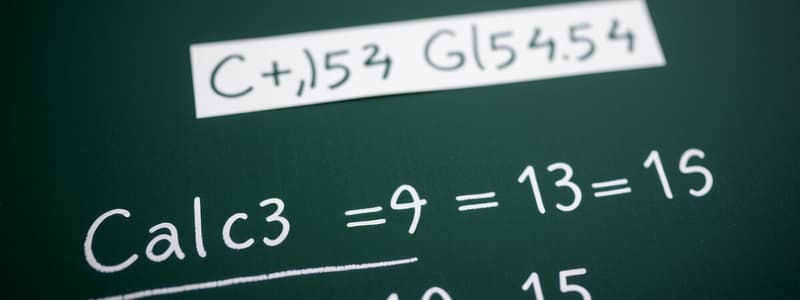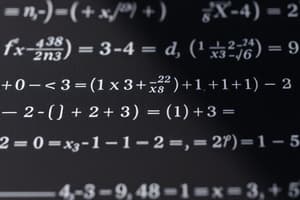Podcast
Questions and Answers
What are limits?
What are limits?
- The value a function approaches (correct)
- The slope of a function
- The minimum value of a function
- The maximum value of a function
What does DNE stand for?
What does DNE stand for?
Does Not Exist
Unbounded limits result in DNE.
Unbounded limits result in DNE.
True (A)
What does Lim f(x) x --> c^+ represent?
What does Lim f(x) x --> c^+ represent?
What does Lim f(x) x --> c^- represent?
What does Lim f(x) x --> c^- represent?
The limit of f(x) x --> c exists when Lim f(x) x --> c^+ and Lim f(x) x --> c^- are the same.
The limit of f(x) x --> c exists when Lim f(x) x --> c^+ and Lim f(x) x --> c^- are the same.
If a one-sided limit is unbounded, the limit exists.
If a one-sided limit is unbounded, the limit exists.
How can you estimate limits from a table?
How can you estimate limits from a table?
A function is undefined where the denominator equals what?
A function is undefined where the denominator equals what?
What is the sum property of limits?
What is the sum property of limits?
What is the product property of limits?
What is the product property of limits?
What is the Constant Multiple Rule?
What is the Constant Multiple Rule?
What is the exponent limit rule?
What is the exponent limit rule?
What should you do with piecewise function limits if DNE occurs?
What should you do with piecewise function limits if DNE occurs?
What is 'f o g'?
What is 'f o g'?
What should be done when the internal or external limit does not exist?
What should be done when the internal or external limit does not exist?
What is Direct Substitution?
What is Direct Substitution?
When evaluating a limit, the denominator can equal zero.
When evaluating a limit, the denominator can equal zero.
How do you find limits of piecewise functions?
How do you find limits of piecewise functions?
What is the process for limits by factoring?
What is the process for limits by factoring?
What does (a+b)(a-b) equal?
What does (a+b)(a-b) equal?
What does (√a+b)(√a-b) equal?
What does (√a+b)(√a-b) equal?
What is sin²x + cos²x equal to?
What is sin²x + cos²x equal to?
What is cos 2x equal to?
What is cos 2x equal to?
What is cos²x - sin²x equal to?
What is cos²x - sin²x equal to?
What is 1 - 2sin²x equal to?
What is 1 - 2sin²x equal to?
What is the Squeeze Theorem?
What is the Squeeze Theorem?
What is lim x->0 sin(x)/x equal to?
What is lim x->0 sin(x)/x equal to?
What is lim -> 0 (1 - cos(x) / x) equal to?
What is lim -> 0 (1 - cos(x) / x) equal to?
What is point discontinuity?
What is point discontinuity?
What is jump discontinuity?
What is jump discontinuity?
What is asymptotic discontinuity?
What is asymptotic discontinuity?
F is continuous at x=c if lim f(x) x -> c = f(c).
F is continuous at x=c if lim f(x) x -> c = f(c).
What is the average rate of change formula?
What is the average rate of change formula?
What does the Mean Value Theorem state?
What does the Mean Value Theorem state?
What does the Extreme Value Theorem state?
What does the Extreme Value Theorem state?
What are critical points?
What are critical points?
How do you find critical points?
How do you find critical points?
The function is decreasing when f'(x) < 0.
The function is decreasing when f'(x) < 0.
What is relative maximum?
What is relative maximum?
Flashcards are hidden until you start studying
Study Notes
Limits
- Limits indicate the value that a function approaches as the variable approaches a certain point, denoted as ( \lim_{x \to c} f(x) ).
- A limit can exist even if the function is undefined at that point.
- DNE (Does Not Exist) occurs when a left-hand limit and right-hand limit yield different values.
- Unbounded limits also result in DNE.
One-sided Limits
- ( \lim_{x \to c^+} f(x) ): Represents the limit as ( x ) approaches ( c ) from the right.
- ( \lim_{x \to c^-} f(x) ): Represents the limit as ( x ) approaches ( c ) from the left.
- If both one-sided limits are the same, the two-sided limit exists.
Calculating Limits
- Estimating limits using a table: Lower values indicate left limits, and higher values indicate right limits.
- Direct substitution involves plugging the value directly into the function to evaluate limits.
Properties of Limits
- The Sum Property: ( \lim (f(x) + g(x)) = \lim f(x) + \lim g(x) )
- The Product Property: ( \lim (f(x) \cdot g(x)) = \lim f(x) \cdot \lim g(x) )
- Constant Multiple Rule: If ( c ) is a constant, then ( \frac{d}{dx}[c f(x)] = c f'(x) ).
Special Limit Cases
- The limit of ( \frac{\sin x}{x} ) as ( x \to 0 ) is 1.
- The limit of ( \frac{1 - \cos x}{x} ) as ( x \to 0 ) is 0.
Piecewise Functions
- For limits involving piecewise functions, evaluate the limits separately for each side of the point of interest.
- Factorization can help simplify limit evaluation; undefined values indicate crossings of the function.
Types of Discontinuities
- Point Discontinuity: Exists where the function has a hole in the graph; it's removable.
- Jump Discontinuity: Function jumps to a different y-value, non-removable.
- Asymptotic Discontinuity: Approaches an asymptote, resulting in non-removable discontinuity.
Continuity and Critical Points
- A function ( f ) is continuous at ( x = c ) if ( \lim_{x \to c} f(x) = f(c) ).
- A critical point occurs where ( f' = 0 ) or ( f' ) is undefined, which may indicate local maxima or minima.
Theorems
- Mean Value Theorem: There exists at least one point where the instantaneous rate of change equals the average rate of change on an interval.
- Extreme Value Theorem: A continuous function on a closed interval has both an absolute maximum and minimum.
Additional Trigonometric Identities
- ( \sin^2 x + \cos^2 x = 1 )
- ( \cos(2x) = \cos^2 x - \sin^2 x )
- Alternative forms include ( \cos^2 x - \sin^2 x = 1 - 2 \sin^2 x ) and ( 1 - 2 \sin^2 x = 2 \cos^2 x - 1 ).
Finding Critical Points
- To find critical points, take the derivative, set it to zero, and test the intervals using a number line.
Studying That Suits You
Use AI to generate personalized quizzes and flashcards to suit your learning preferences.




